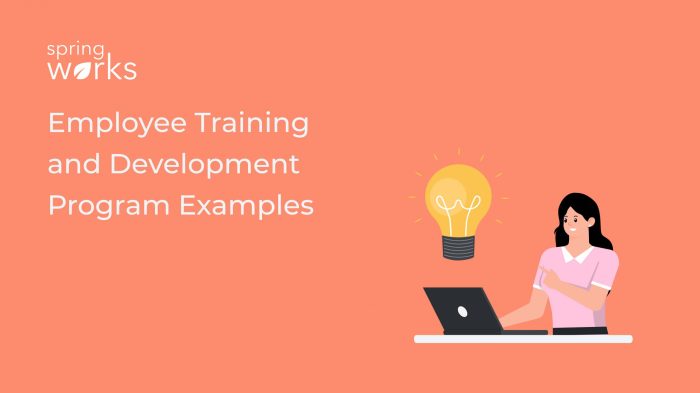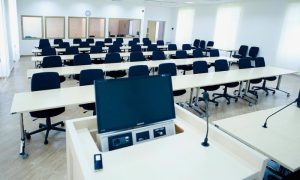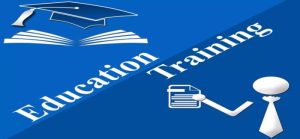
Ever wondered about the subtle yet significant differences between education and training? Prepare for a whirlwind tour through the fascinating world of learning! We’ll explore everything from kindergarten classrooms to cutting-edge corporate training programs, uncovering the diverse methods, technologies, and impactful results that shape individuals and societies. Get ready to dive into a world where knowledge is power, skills are gold, and lifelong learning is the ultimate adventure!
This guide delves into the core concepts of education and training, examining their distinct characteristics, methodologies, and the vital role they play in personal and professional growth. We’ll journey through various examples, from traditional classroom settings to innovative online platforms, highlighting the evolution and future trends of this ever-changing landscape. Prepare to be inspired by the transformative power of learning!
Defining Education and Training
Education and training are often used interchangeably, but they represent distinct yet complementary processes aimed at improving knowledge, skills, and abilities. While both contribute to personal and professional development, their approaches, objectives, and outcomes differ significantly. Understanding these differences is crucial for individuals and organizations seeking to maximize their learning potential.
Education and Training: A Clear Distinction
Education is a broad, holistic process encompassing the acquisition of knowledge, skills, values, beliefs, and habits. It’s a lifelong journey focused on intellectual development and the cultivation of critical thinking, problem-solving, and creativity. In contrast, training is a more focused, targeted process designed to develop specific skills and competencies needed for a particular job, task, or activity. Training typically emphasizes practical application and immediate performance improvement.
Think of education as building a strong foundation, while training builds a specific structure upon that foundation.
Types of Education and Training
Numerous types of education and training cater to diverse needs and learning styles. Formal education, such as primary, secondary, and higher education, follows a structured curriculum and leads to recognized qualifications. Informal education, on the other hand, occurs through everyday experiences, interactions, and self-directed learning. Examples include learning a new language through immersion or gaining practical skills through hobbies.
Vocational training provides specialized skills for specific occupations, often involving apprenticeships or on-the-job training. Continuing professional development (CPD) programs help professionals update their knowledge and skills throughout their careers. Distance learning and online courses offer flexible and accessible educational opportunities.
Objectives and Outcomes of Education and Training
The primary objective of education is to foster intellectual growth, critical thinking, and personal development. Outcomes include increased knowledge, improved cognitive abilities, enhanced problem-solving skills, and the development of a well-rounded perspective. Training, conversely, aims to improve specific skills and competencies relevant to a particular task or job role. Successful training results in increased efficiency, improved performance, enhanced productivity, and the ability to perform specific tasks proficiently.
Comparison of Education and Training Methodologies
| Feature | Education | Training |
|---|---|---|
| Focus | Broad, holistic development | Specific skills and competencies |
| Methodology | Lectures, discussions, research, projects, assessments | On-the-job training, simulations, workshops, demonstrations, practice exercises |
| Assessment | Exams, essays, presentations, research papers | Performance evaluations, skill tests, practical demonstrations |
| Timeframe | Often long-term, spanning years | Can be short-term, focused on immediate skill acquisition |
Examples of Education and Training Programs
Education and training programs exist across a wide spectrum, catering to diverse needs and aspirations, from foundational literacy to highly specialized professional skills. These programs are crucial for individual growth and societal advancement, equipping people with the knowledge and abilities necessary to thrive in a constantly evolving world. Let’s explore some key examples across various sectors.
Formal Education Programs
Formal education programs follow a structured curriculum, typically leading to recognized qualifications. These programs are generally categorized into primary, secondary, and higher education levels. Primary education lays the foundation for literacy and numeracy, typically encompassing kindergarten through elementary school. Secondary education builds upon this foundation, introducing more complex subjects and often culminating in a high school diploma or equivalent.
Higher education encompasses undergraduate and postgraduate studies at universities and colleges, leading to degrees such as Bachelor’s, Master’s, and Doctoral degrees. Examples include a primary school curriculum focusing on reading, writing, and arithmetic; a secondary school curriculum incorporating science, mathematics, and humanities; and a university program offering a Bachelor of Science in Computer Science.
Vocational Training Programs
Vocational training programs focus on acquiring specific job-related skills. These programs are often shorter and more hands-on than formal academic programs, providing practical training that prepares individuals for immediate employment. Examples include programs in welding, where students learn to join metals using various techniques; culinary arts programs, teaching students the principles of cooking and food preparation; and automotive technician programs, which provide training in vehicle repair and maintenance.
The emphasis is always on practical application and industry-relevant skills.
Corporate Training Programs
Corporate training programs are designed to enhance the skills and knowledge of employees within an organization. These programs can range from onboarding sessions for new hires to advanced leadership development programs for experienced managers. Examples include sales training programs designed to improve sales techniques and customer relationship management; software training programs focused on specific applications used within the company; and leadership development programs that focus on enhancing communication, decision-making, and team management skills.
The goal is to improve employee performance and contribute to the overall success of the company.
Examples of Online Education and Training Platforms
Online learning has revolutionized access to education and training. Many platforms offer a variety of courses and programs, making learning more accessible and flexible.
- Coursera: Offers courses from top universities and organizations worldwide.
- edX: Provides massive open online courses (MOOCs) from leading universities.
- Udemy: A platform with a vast library of courses on diverse topics.
- LinkedIn Learning: Focuses on professional development courses relevant to career advancement.
- Khan Academy: Offers free educational resources covering a wide range of subjects.
Methods and Approaches in Education and Training
Effective education and training rely on a diverse range of pedagogical approaches and methodologies. Choosing the right method depends heavily on the learning objectives, the learners’ characteristics, and the available resources. This section explores various methods, comparing their strengths and weaknesses to highlight their suitability for different contexts.
Pedagogical Approaches in Education
Educational pedagogy encompasses a broad spectrum of approaches, each with its own philosophy and techniques. Two prominent examples are constructivism and behaviorism. Constructivism emphasizes active learning, where students construct their own understanding through experience and reflection. Learners are encouraged to explore, experiment, and collaborate, building knowledge through interaction and problem-solving. In contrast, behaviorism focuses on observable behaviors and the principles of reinforcement and punishment.
Learning is viewed as a process of acquiring and modifying behaviors through stimulus-response associations. While seemingly disparate, these approaches often complement each other in effective teaching strategies. For instance, a constructivist approach might utilize behaviorist principles to reward positive learning behaviors.
Training Methodologies
The world of training employs a variety of methodologies to impart skills and knowledge effectively. On-the-job training (OJT) provides practical experience within a real-world work environment, allowing trainees to learn by doing under the guidance of experienced professionals. Simulations, on the other hand, offer a safe and controlled environment to practice skills and decision-making in situations that mirror real-life scenarios.
This is particularly useful in high-risk professions like aviation or surgery. E-learning utilizes technology to deliver training materials and assessments online, offering flexibility and scalability. This method is particularly advantageous for geographically dispersed learners or those with busy schedules. Each methodology presents unique advantages and disadvantages depending on the specific training goals.
Comparison of Teaching Methods Effectiveness
The effectiveness of different teaching methods is context-dependent and influenced by factors like learner characteristics, subject matter, and available resources. For instance, while e-learning offers flexibility, it may lack the immediate feedback and social interaction crucial for certain learning styles. Similarly, OJT provides valuable real-world experience, but it can be resource-intensive and less structured than classroom-based instruction. A blended approach, combining different methods, often yields the best results by leveraging the strengths of each.
For example, a training program might use e-learning modules for initial knowledge acquisition, followed by simulations to practice skills and finally OJT for practical application and refinement.
Strengths and Weaknesses of Training Delivery Methods
| Training Delivery Method | Strengths | Weaknesses | Best Suited For |
|---|---|---|---|
| On-the-Job Training (OJT) | Practical experience, immediate feedback, cost-effective (in some cases), tailored to specific job tasks | Time-consuming, inconsistent quality depending on trainer, potential safety risks, disruptive to workflow | Skills requiring hands-on practice, apprenticeship models |
| Simulations | Safe environment for practice, repeatable scenarios, cost-effective alternative to real-world practice, allows for experimentation | Can be expensive to develop, may not perfectly replicate real-world complexity, requires specialized software/hardware | High-risk scenarios, complex decision-making, procedural training |
| E-learning | Flexible, scalable, cost-effective, accessible to geographically dispersed learners, self-paced learning | Requires technology access, potential for learner isolation, limited interaction, difficult to assess practical skills | Large groups, diverse locations, foundational knowledge delivery |
| Classroom Instruction | Structured learning environment, immediate interaction with instructor and peers, effective for complex concepts, facilitates collaborative learning | Can be expensive, inflexible scheduling, limited scalability, requires physical presence | Interactive learning, group discussions, complex theoretical concepts |
The Role of Technology in Education and Training
Technology has revolutionized the landscape of modern education and training, transforming how knowledge is delivered, accessed, and assessed. Its impact spans from kindergarten classrooms to corporate boardrooms, offering unprecedented opportunities for personalized learning, global collaboration, and efficient knowledge dissemination. The integration of technology is no longer a luxury but a necessity for institutions aiming to remain competitive and relevant in the rapidly evolving digital age.Technology’s influence on education and training is multifaceted.
It provides access to a vast array of learning resources, from online encyclopedias and digital libraries to interactive simulations and virtual reality experiences. This accessibility democratizes education, breaking down geographical barriers and making learning opportunities available to a wider audience than ever before. Furthermore, technology facilitates personalized learning pathways, catering to individual learning styles and paces through adaptive learning platforms and intelligent tutoring systems.
The use of data analytics allows educators to track student progress, identify areas needing improvement, and tailor instruction accordingly.
Examples of Educational Technologies and Their Applications
Educational technologies encompass a wide range of tools and platforms. Learning Management Systems (LMS), such as Moodle or Canvas, provide centralized platforms for course delivery, communication, and assessment. Interactive whiteboards enhance classroom engagement, allowing for collaborative learning and dynamic presentations. Educational apps, available on smartphones and tablets, offer gamified learning experiences and personalized practice exercises. Virtual and augmented reality (VR/AR) technologies create immersive learning environments, particularly useful for subjects like science, engineering, and medicine.
For example, medical students can practice surgical procedures in a simulated environment using VR, minimizing risk and maximizing learning efficiency. Similarly, engineering students can design and test virtual prototypes using CAD software, gaining valuable hands-on experience without the need for expensive physical materials.
Challenges and Opportunities Presented by Technology in Education and Training
While technology offers immense potential, its integration also presents challenges. The digital divide, where access to technology and internet connectivity varies significantly across populations, creates inequities in educational opportunities. Concerns regarding data privacy and security are paramount, requiring robust measures to protect sensitive student information. The effective integration of technology requires teacher training and ongoing professional development, ensuring educators are equipped to utilize these tools effectively and integrate them meaningfully into their teaching practices.
Moreover, the potential for distraction and misuse of technology in the learning environment needs careful management. However, the opportunities outweigh the challenges. Technology can foster collaboration across geographical boundaries, connecting learners and educators worldwide. It enables personalized learning experiences, adapting to individual needs and preferences. It also allows for continuous learning and professional development, fostering lifelong learning habits.
Benefits and Drawbacks of Online Learning
The rise of online learning has presented both advantages and disadvantages. It’s crucial to consider both sides to make informed decisions about its application.
- Benefits: Increased flexibility and accessibility, personalized learning pace, cost-effectiveness (often lower tuition fees than traditional institutions), broader course selection, self-paced learning, potential for global collaboration.
- Drawbacks: Requires self-discipline and motivation, potential for isolation and lack of social interaction, technological dependence and potential for disruptions, difficulty in assessing learning outcomes accurately, requires reliable internet access and suitable technology.
Assessing Effectiveness of Education and Training
Evaluating the success of education and training programs is crucial for ensuring resources are used effectively and learning outcomes are achieved. A multifaceted approach, incorporating various methods, is necessary to gain a comprehensive understanding of program impact. This involves examining participant learning, changes in behavior, and ultimately, the effect on organizational performance.
Methods for Evaluating Program Effectiveness
Several methods can be employed to assess the effectiveness of educational programs. These methods offer different perspectives on learning and impact, and using a combination often provides the most robust evaluation. Choosing the right method depends on the specific program goals and available resources.
- Pre- and Post-Tests: These measure changes in knowledge and skills before and after the program. A significant improvement indicates effective learning. For example, a pre-test might assess a participant’s understanding of basic accounting principles, followed by a post-test after a training program on advanced accounting techniques. The difference in scores demonstrates the program’s impact on knowledge acquisition.
- Observations: Direct observation of participants applying learned skills in real-world or simulated settings provides valuable insights into practical application. For instance, observing trainees using new software in a simulated workplace environment can assess their proficiency and identify areas needing improvement.
- Surveys and Questionnaires: These gather feedback on participant satisfaction, perceived learning, and program usefulness. This provides valuable qualitative data supplementing quantitative measures from tests and observations. A well-designed survey can uncover hidden issues or areas for improvement not apparent through other methods.
- Performance Data: Measuring changes in employee performance metrics (e.g., sales figures, error rates, customer satisfaction scores) after training provides evidence of real-world impact. For example, a sales training program’s success can be measured by comparing sales figures before and after the training.
- Focus Groups: These provide qualitative data through in-depth discussions with participants, offering rich insights into their learning experiences and perceptions. Focus groups can help identify areas where the program excelled or fell short and reveal underlying issues affecting learning.
Measuring Training Impact on Employee Performance
Measuring the impact of training on employee performance requires a strategic approach. It’s not enough to simply ask employees if they enjoyed the training; concrete data is needed to demonstrate a return on investment.
Effective measurement involves identifying key performance indicators (KPIs) relevant to the training objectives. These KPIs should be measurable and directly related to the skills or knowledge imparted in the training. For example, a training program on customer service might use KPIs such as customer satisfaction scores, complaint resolution time, and repeat customer rates. Changes in these KPIs after the training provide evidence of its effectiveness.
Baseline data collected before the training is essential for accurate comparison.
The Importance of Feedback Mechanisms
Feedback mechanisms are crucial for both education and training. They provide valuable information for program improvement and enhance the learning experience. Feedback should be gathered from various sources, including participants, instructors, and supervisors. This multifaceted approach offers a more complete picture of program effectiveness.
In education, feedback might involve student evaluations of courses, instructor feedback on student assignments, and peer feedback on group projects. In training, feedback can be collected through post-training surveys, performance reviews, and observations of on-the-job application of learned skills. Regular feedback loops allow for continuous improvement and adaptation to meet evolving needs.
Questionnaire to Assess Training Program Effectiveness
This questionnaire aims to assess the effectiveness of a customer service training program.
| Question | Response Type |
|---|---|
| How satisfied were you with the overall training program? | Rating scale (1-5, 1=Very Dissatisfied, 5=Very Satisfied) |
| How much did you learn from this training program? | Rating scale (1-5, 1=Very Little, 5=Very Much) |
| How relevant was the training content to your job? | Rating scale (1-5, 1=Not at all Relevant, 5=Very Relevant) |
| How confident are you in applying the skills learned in your daily work? | Rating scale (1-5, 1=Not at all Confident, 5=Very Confident) |
| What aspects of the training were most beneficial? | Open-ended text |
| What aspects of the training could be improved? | Open-ended text |
| Would you recommend this training program to others? | Yes/No |
EDUCATION AND TRAINING
Education and training are not isolated events; they are interwoven threads that shape an individual’s life journey, from early childhood to retirement and beyond. This holistic view emphasizes the continuous and interconnected nature of learning and development, highlighting its profound impact on personal growth and societal progress.
This interconnectedness is evident across various life stages. Early childhood education lays the foundation for cognitive and social-emotional development, influencing future academic success and life choices. Formal schooling builds upon this foundation, providing specialized knowledge and skills. Vocational training equips individuals with practical skills for specific careers, while higher education fosters critical thinking, problem-solving, and advanced knowledge in chosen fields.
Throughout adulthood, continuous professional development and lifelong learning become crucial for adapting to evolving job markets and maintaining personal relevance.
Lifelong Learning and Continuous Professional Development
Lifelong learning transcends formal education, encompassing a commitment to continuous self-improvement and skill enhancement throughout life. Continuous professional development (CPD) focuses specifically on maintaining and upgrading professional competencies, often driven by industry demands and career aspirations. Both are vital for individual success and societal advancement. The rapid pace of technological change and globalization necessitates constant adaptation, making lifelong learning and CPD not merely desirable, but essential for remaining competitive in the workforce.
For example, a software engineer needs to continuously learn new programming languages and frameworks to stay relevant, while a teacher needs to update their pedagogical approaches and knowledge base to meet evolving educational standards.
Societal Impact of Effective Education and Training Initiatives
Effective education and training initiatives contribute significantly to a nation’s social fabric. Improved literacy rates lead to increased civic engagement and informed decision-making. Enhanced critical thinking skills empower individuals to navigate complex social issues and participate constructively in democratic processes. Equitable access to quality education and training reduces social inequalities, promoting social cohesion and reducing disparities. For instance, programs focused on adult literacy and digital skills can significantly empower marginalized communities, improving their economic prospects and social mobility.
Contribution to Economic Growth and Social Progress
Education and training are fundamental drivers of economic growth and social progress. A skilled workforce is crucial for attracting foreign investment and fostering innovation. Increased productivity, driven by a well-trained workforce, boosts economic output and improves standards of living. Furthermore, education fosters entrepreneurship, leading to the creation of new businesses and job opportunities. Countries with strong education and training systems generally experience higher levels of economic growth and improved social indicators, such as lower poverty rates and improved health outcomes.
The success of countries like South Korea and Singapore, which prioritized education and training, serves as a powerful example of the link between human capital development and national prosperity. Their investment in education and skills development fueled economic growth and improved living standards for their citizens.
Future Trends in Education and Training

The landscape of education and training is undergoing a rapid transformation, driven by technological advancements, evolving learner needs, and a globalized world. We are moving beyond traditional classroom models towards more personalized, flexible, and technology-enhanced learning experiences. This shift promises to democratize access to education and create a more agile and adaptable workforce.
Several key trends are shaping the future of education and training, impacting how we learn, teach, and assess knowledge and skills.
Emerging Trends in Education and Training
The convergence of several factors is reshaping education and training. Microlearning, personalized learning pathways, gamification, and the rise of skills-based education are all contributing to a more dynamic and effective learning environment. Furthermore, the increasing demand for lifelong learning and upskilling is pushing institutions and organizations to adopt more agile and responsive approaches to education and training delivery.
This means that learning is no longer a one-time event, but rather a continuous process that adapts to the ever-changing needs of individuals and the workforce.
The Impact of Artificial Intelligence on Education and Training
Artificial intelligence (AI) is poised to revolutionize education and training. AI-powered tools can personalize learning experiences by adapting to individual student needs and learning styles. For example, intelligent tutoring systems can provide customized feedback and support, while AI-driven assessment tools can offer more accurate and efficient evaluations. Furthermore, AI can automate administrative tasks, freeing up educators to focus on more meaningful interactions with students.
Consider platforms like Khan Academy, which uses AI to personalize learning paths, or Duolingo, which leverages AI to adapt to individual language learning progress. These are early examples, and the potential for AI to transform education is vast.
Predictions for the Future of Learning and Development
The future of learning and development will likely be characterized by increased personalization, flexibility, and accessibility. We can anticipate a greater emphasis on experiential learning, project-based learning, and collaborative learning environments. The lines between formal and informal learning will continue to blur, with learners increasingly leveraging online resources, social media, and other platforms to acquire new knowledge and skills.
For example, the rise of online learning platforms like Coursera and edX demonstrates the growing demand for flexible and accessible learning opportunities. We also anticipate a significant increase in the use of virtual and augmented reality technologies to create immersive and engaging learning experiences. Companies like Google and Microsoft are already investing heavily in these technologies for educational purposes.
A Visual Representation of the Future Landscape of Education and Training
Imagine a vibrant, interconnected ecosystem of learning. Individual learners navigate personalized learning pathways, supported by AI-powered tutors and adaptive learning platforms. Virtual and augmented reality environments provide immersive learning experiences, while collaborative online spaces foster teamwork and knowledge sharing. Traditional classrooms still exist, but they are enhanced by technology and focused on fostering critical thinking, creativity, and problem-solving skills.
The entire system is dynamic and responsive, constantly adapting to the evolving needs of learners and the workforce. This ecosystem seamlessly integrates formal and informal learning, creating a continuous cycle of learning and development throughout an individual’s life.
Final Conclusion

From the foundational principles of education to the dynamic strategies of modern training, we’ve journeyed through a landscape of learning, exploring its diverse forms and far-reaching impacts. The key takeaway? Education and training are not just about acquiring knowledge and skills; they are about fostering growth, innovation, and progress—both individually and collectively. So, embrace the lifelong learning journey, and watch your potential soar!
Quick FAQs
What’s the difference between a curriculum and a training syllabus?
A curriculum is a broader, more comprehensive plan outlining the overall learning objectives and content for a subject or field of study. A training syllabus, on the other hand, focuses specifically on the skills and knowledge needed for a particular training program, often more targeted and outcome-oriented.
How can I measure the ROI of a training program?
Measure improvements in employee performance (productivity, efficiency, quality of work), reduced errors, increased customer satisfaction, and employee retention rates. Compare these post-training metrics to pre-training baselines.
What are some emerging trends in microlearning?
Microlearning is trending towards greater personalization, gamification, and the integration of AI-powered tools for adaptive learning paths and personalized feedback.
Are there free online resources for professional development?
Yes! Many platforms like Coursera, edX, and Khan Academy offer free courses and resources on a vast array of subjects. LinkedIn Learning also offers a free trial period.






